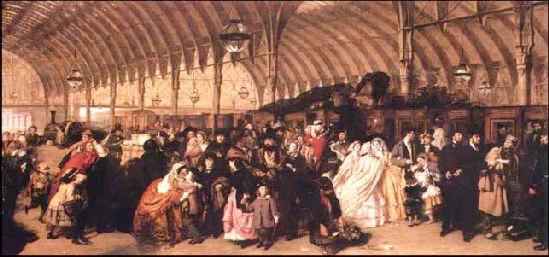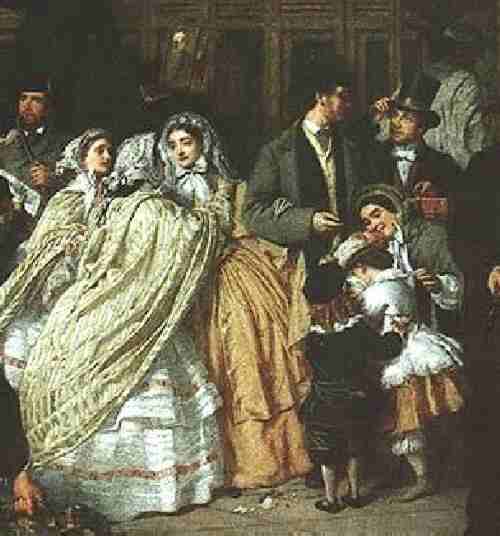
Artists Illustrating Boys' Fashions: William Powell Frith (England, 1819-1909)

Figure 1.--The railroad became the key to 19th century industrial development and before the invention of the automobile, the principal mode of trnasportation. Frith's Railroad Station provides a wonderful insight in transportation in the 1860s and how people dressed. It pictured London's Padington Station.
|
William Powell Frith was the son of domestic servants. He became a noted genre painter, renowned for his large-scale portraits of modern life subjects such as the railroad station. His renown was so great that he was awarded a commission to paint the Prince of Wales' group wedding portrait. He had some difficulty with the future Edward VII's German nephew Wilhelm. His work commaned high prices in the 1870s.
Childhood
William Powell Frith was the son of domestic servants. He was born in Alfielda village near Ripon in 1819. The family moved to Harrogate when he was 7 years old.
Childhood Clothing
We have no information on the clothing that Frith wore as a boy.
Education
His father encouraged William's artistic talents, he began his art training at Saint Margaret's School, Dover. Frith began attending Henry Sass Academy in London during 1835. A contemporary student there was Edward Lear. He then won a place at the Royal Academy Schools in 1837.

Figure 2.--Frith's 1862 painting Railroad Station shows how people dressed to travel in the 1860s. A few children appear in the scene, although details are hard to make out in the available images. One appears to be a boy in a velvet suit with lace collar and ringlet curls.
|
Career
While a student Frith earned money by painting portraits. In 1845 he was appointed an associate of the Royal Academy and was made a full member in 1853. Frith exhibited the first of this three great modern-life subjects, Life at the Seaside: Ramsgate Sands in 1854. This was followed by Derby Day (1858) and The Railway Station (1862). These paintings proved very popular and Frith sold a large number of engravings of these works. Soon after the Railway Station he received a commission to paint the group scene of the Prince of Wales wedding. In 1875 Frith's painting Before Dinner in Boswell's Lodgings (1868) was sold for £4,567. At the time, it was the highest salesroom price paid for the work of a living artist. He was critical of trends in modern art. He decried the Pre-Raphaelites and other schools inspired by the Impressionists. He authored articles against them in the Magazine of Art.
Work
Frith was a noted genre painter, important in that he produced pictures that encapsulated contemporary Victorian life. His early
work was mainly scenes from the classics, from more modern literature and history paintings. He never stopped painting these scenes. He found his niche, however, with Ramsgate Sands (Life at the Seaside) (1851), the first of many panoramas of Victorian life. The two most famous were Derby Day (1858) and The Railway Station (1862), the
latter showing a scene in Paddington Station. He painted these on large canvases with crowds of people and paid close attention details. While many painters had attmpted the classics, his contemprary scenes were inovative and attracted considerable attention. They are today wonderfull historical documents.
Wedding Portrait
Frith's fame led to a commission from the royal family to paint a group portrait of the Prince of Wales' 1863 wedding to Danish Princess Alexandra. While prestigious, the commission proved to be among the most difficult for the aclaimed artist--thanks largely to the youngest member of the wedding party--the Prince if Wales' German nephew Wilhelm. (Wilhelm wa of course the future Kaiser Wilhelm II.) His mother Victoria had returned to Windsor 8 months after the wedding so she and Wilhelm could sit for the portrait.
Wilhelm had aquited himself with some familar notariety by flining his 5-year old Aunt Beatrice's muff out a chairage window and then during the ceremony tossing the dirk in the kneesocks of his highlands kilt costume across the floor of St. Georges chapel during the ceremony. Willy as he was called within the family apparently was little changed upon his return. Willy was fascinated to watch the painting take shape, but was also struck by the artist's whiskers. "Mr. Fiff, you are a nice man, but your whiskers ..." His Aunt Helena immediately put her hand over his mouth. Willy struggled free and repeated himself even more loudly. She stopped him again, but could not keep from giggling herself. She led him away and gave him a lecture on coutesy.
Frith could hardly order the "royal imp out" he came upon the idea of allowing Willy to paint his own daubs on a small part of the vast canvas. This work for a while until his nurse came in and found his fave streaked with paint. He had been wiping the brushes on his face. The nuese cried out in horror. Frith assured her that he could clean Willy up with a little turpentine. Unfortunately Willy had a scratch on his face and he started screaming. He struck the artist as hard as he could with his little fist. He then sought refuge under a table and howled until exhausted. Afterwards he proved a very uncooperative sitter and Frith failed to achieve more than a vague likness.
Critics
His work was heavily criticized by the art establishment and considered "vulgar". The artist was accused of being more interested in subject than in painting, "devoted to telling stories on canvas....eminent among men who paint for those who like pictures without liking art"'. Of course it was just this approach that made him popular with the contemporary public and the reason his work attracts so much attention today. His works do indeed tell stories. In the Railroad Station next to a mother with two small children, the boy in the velvet suit, a man is being arrested by plain clothes detectives.
Later Years
Frith continued to paint crowd scenes but in his later years his work was considered old-fashioned. Frith died in 1909.
Sources
See his memoirs, A Victorian Canvas (1957).
Christopher Wagner

Navigate the Boys' Historical Clothing Web Site:
[Return to the Main individual "A-L" artists alphabetical page]
[Introduction]
[Activities]
[Bibliographies]
[Biographies]
[Chronology]
[Clothing styles]
[Contributions]
[Countries]
[Boys' Clothing Home]
Created: June 30, 2001
Last updated: June 30, 2001




